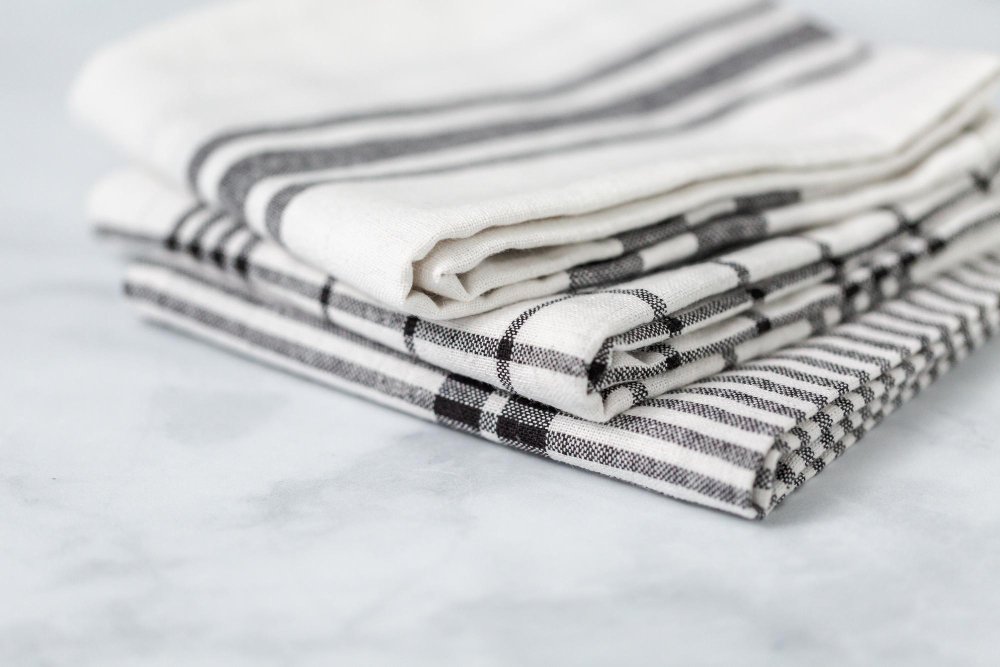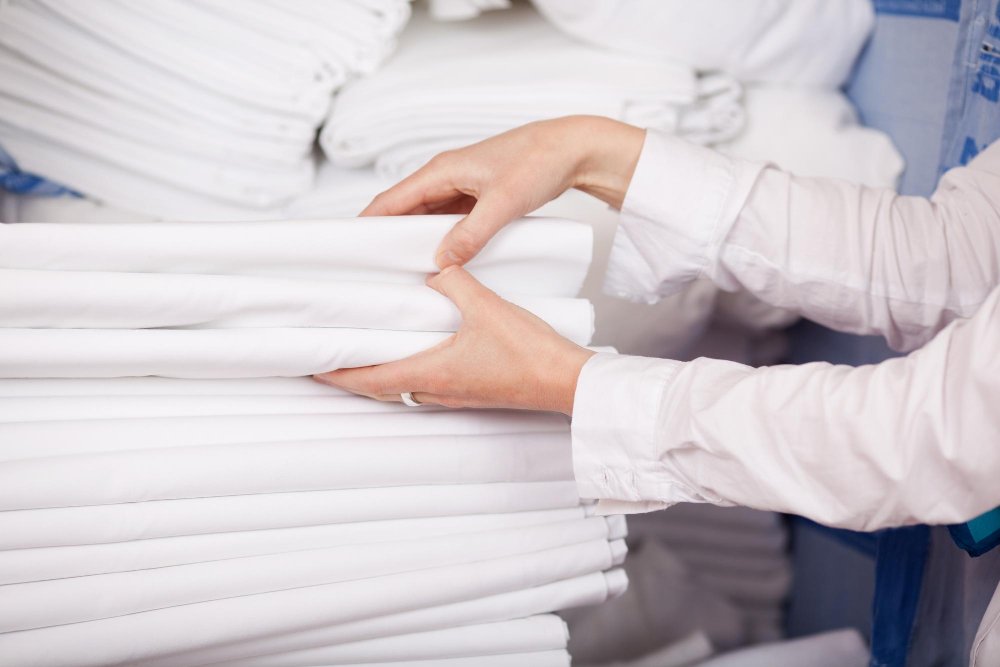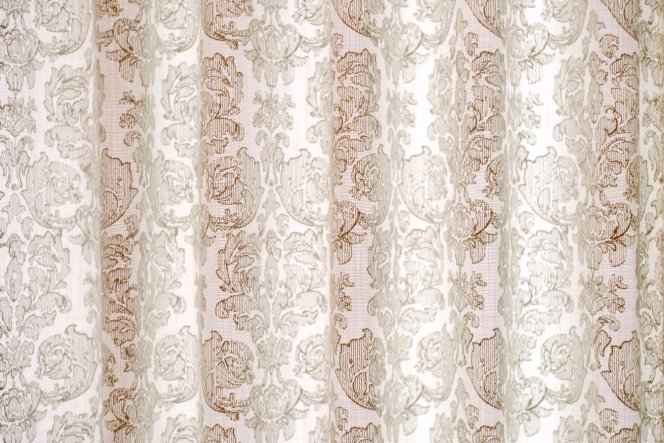Everything you need to know about linen toweling – from how it compares to cotton to why it’s worth the investment for your home
Table of Contents
- What is Linen Towel Fabric?
- Linen vs. Cotton Towels: The Complete Comparison
- Different Fabric Types for Towels
- Key Benefits of Linen Towels
- Understanding GSM Weight in Linen Towels
- How to Wash and Care for Linen Towels
- Are Linen Towels Worth the Price?
- How to Choose the Right Linen Towel
- Design and Style Options
- Honest Drawbacks to Consider
- Frequently Asked Questions
- Conclusion
What is Linen Towel Fabric?
Linen towel fabric is a textile made from flax plant fibers, specifically designed for drying and absorption. Unlike traditional terry cloth cotton towels with their looped pile structure, linen towels feature a flat weave or waffle pattern that creates a smooth, textured surface.
The flax plant (Linum usitatissimum) grows primarily in cooler European climates, particularly in France and Belgium. Every part of the plant serves a purpose, from the fibers used in linen fabric to the seeds processed into linseed oil and animal feed. This zero-waste characteristic makes linen one of the most sustainable textile options available. Historical textile research shows linen has been produced for thousands of years, with archaeological evidence dating back to ancient civilizations.
What is Linen Towelling?
Linen towelling refers to the specific construction method used to create absorbent linen textiles. Traditional linen towelling uses either a plain weave or honeycomb (waffle) weave pattern. Some modern linen towels combine linen warp threads with cotton terry loops, creating a hybrid fabric that offers the best of both materials.
The term “towelling” distinguishes absorbent towel fabrics from other linen textiles used for clothing or bedding. While all linen has natural moisture-wicking properties, towelling is specifically engineered for maximum water absorption and quick drying.
What Kind of Fabric Type is Linen?
Linen belongs to the category of natural, plant-based fibers. It’s a bast fiber, meaning it comes from the inner bark (phloem) of the flax plant stem. This places linen in the same family as hemp and jute, though linen fibers are finer and softer than other bast fibers.
The production process involves harvesting flax stalks, retting (soaking to separate fibers), scutching (removing woody parts), and spinning into yarn. This labor-intensive process contributes to linen’s higher cost compared to cotton, but it also creates fibers that are naturally stronger and more durable.
Linen vs. Cotton Towels: The Complete Comparison
The choice between linen and cotton towels comes down to specific performance characteristics. Here’s how they compare side by side:
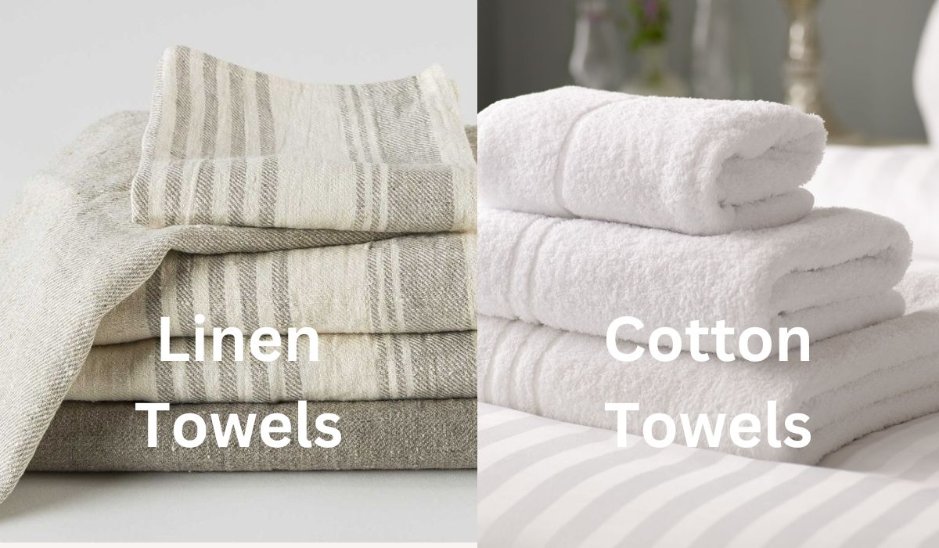
| Feature | Linen Towels | Cotton Terry Towels |
|---|---|---|
| Water Absorption | Holds 20% of weight before feeling damp; absorbs quickly | Very absorbent initially but retains moisture longer |
| Drying Speed | Dries 2-3x faster than cotton | Takes longer to dry; can develop musty odor if damp |
| Lifespan | 20-30 years with proper care | 3-5 years on average |
| Strength | 30% stronger than cotton; even stronger when wet | Good strength but weakens with frequent washing |
| Feel Over Time | Starts crisp, becomes softer and more luxurious with each wash | Starts soft and plush, can become rough and thin over time |
| Weight & Bulk | Lightweight and compact (300-400 GSM) | Heavier and bulkier (400-900 GSM for premium) |
| Odor Resistance | Naturally antibacterial; resists odors | Can retain odors if not dried properly |
| Initial Cost | $30-175 per towel | $10-50 per towel |
| Cost Per Year | $1.50-7 (based on 25-year lifespan) | $2-10 (based on 5-year lifespan) |
| Environmental Impact | Requires less water, fewer pesticides; fully biodegradable | Higher water usage; often treated with pesticides |
| Care Requirements | Wash in cold/lukewarm water; avoid fabric softener | More flexible washing; benefits from fabric softener |
| Storage Space | Compact and space-efficient | Requires more storage space |
Which Fabric is Better for Towels?
There’s no universal “better” option – it depends on your priorities. Linen excels in humid climates, quick-drying situations, and for people who value sustainability and long-term investment. Cotton works better if you prefer immediate plushness, have unlimited storage space, or want the lowest upfront cost.
For most people, linen represents the better long-term choice. The higher initial investment pays off through decades of use, while cotton towels need replacement every few years. Linen also performs better in practical daily use: it dries faster, resists bacteria, and takes up less space in your linen closet.
Different Fabric Types for Towels
Understanding the full spectrum of towel fabrics helps put linen in context:
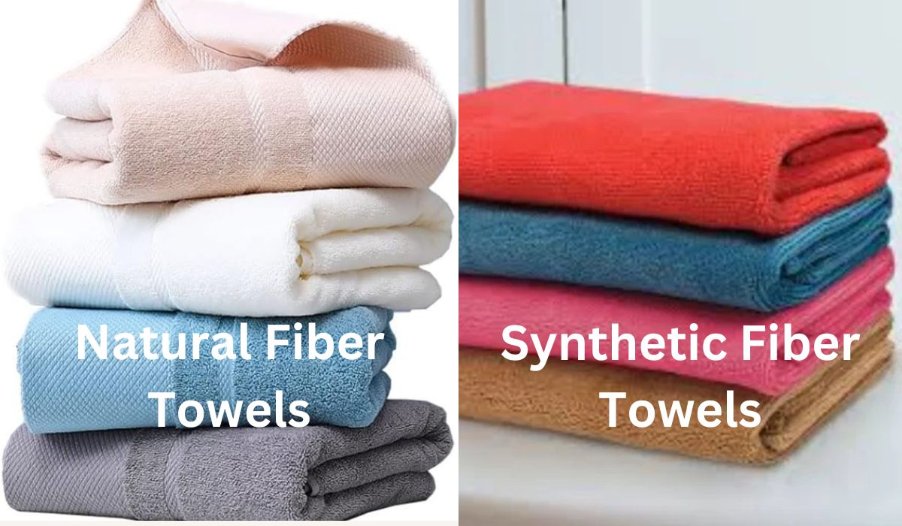
Natural Fiber Towels
Cotton Terry: The most common towel fabric worldwide. Features looped pile on both sides. Available in various qualities from basic to luxury Egyptian or Turkish cotton. Best for: Traditional plushness and immediate softness.
Linen: Flat-weave or waffle construction from flax fibers. Known for quick-drying and durability. Best for: Active lifestyles, travel, and humid climates.
Bamboo: Made from bamboo pulp through chemical processing. Silky soft and naturally antimicrobial. Best for: Sensitive skin and eco-conscious buyers (though processing is less eco-friendly than linen).
Hemp: Similar properties to linen but coarser. Extremely durable and sustainable. Best for: Utility towels and outdoor use.
Synthetic and Blend Towels
Microfiber: Made from polyester and polyamide. Ultra-absorbent and quick-drying. Best for: Sports, gym, and travel use.
Cotton-Polyester Blends: Combines cotton softness with polyester durability. More affordable but less breathable. Best for: Budget-conscious buyers and commercial use.
Linen-Cotton Blends: Merges linen’s quick-drying properties with cotton’s softness. Offers middle-ground performance. Best for: People transitioning from cotton to linen.
Why Choose Linen Over Other Natural Fibers?
Linen stands apart from other natural towel fabrics in three key ways: it’s the strongest natural fiber (especially when wet), it dries fastest among natural options, and it requires the least water and chemicals to produce. While cotton feels softer initially and bamboo offers silkiness, neither matches linen’s combination of durability, performance, and true sustainability.
Key Benefits of Linen Towels
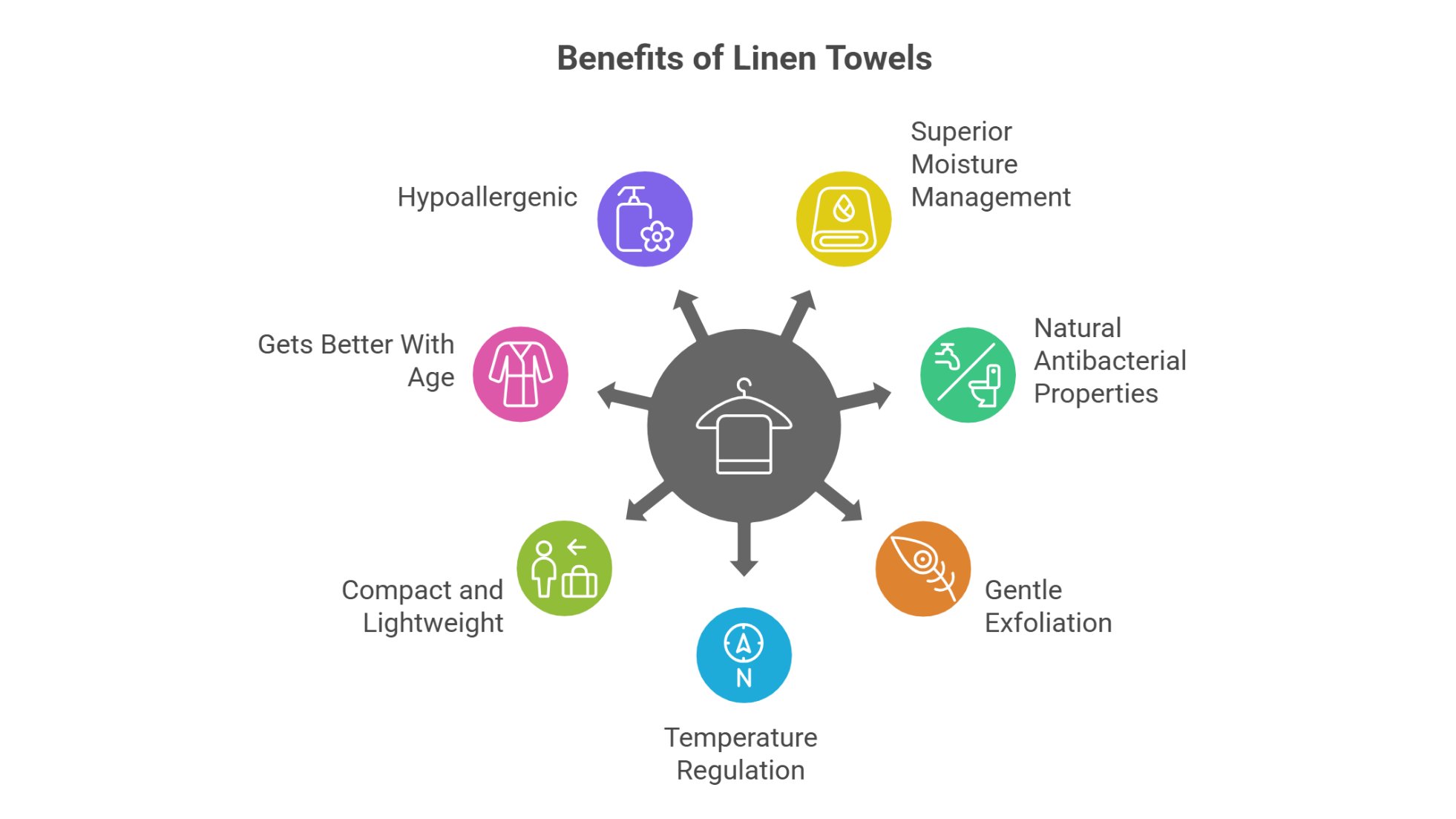
Superior Moisture Management
Linen fibers have a hollow core structure that creates exceptional wicking properties. This means linen pulls water away from your skin quickly, holding up to 20% of its weight before feeling wet to the touch. The open weave structure allows air circulation, speeding evaporation. According to research by the European Flax and Hemp Alliance, linen’s unique fiber structure provides laboratory-proven comfort and moisture management properties.
In practical terms: You dry off faster with less rubbing (better for sensitive skin), towels are ready to reuse within hours, and there’s no damp towel smell even in humid bathrooms.
Natural Antibacterial Properties
The fast-drying nature of linen creates an environment where bacteria and mildew struggle to grow. Unlike cotton towels that stay damp for hours, linen towels dry quickly enough to prevent bacterial colonies from establishing. Scientific studies have documented linen’s natural resistance to bacterial growth and its superior moisture management compared to other textile fibers. This means fresher-smelling towels between washes and a more hygienic bathroom environment.
Gentle Exfoliation
The slightly textured surface of linen towels provides gentle exfoliation as you dry off. This removes dead skin cells without harsh scrubbing, leaving skin smoother and more radiant. People with sensitive skin often prefer this gentle exfoliation to abrasive loofahs or scrubs.
Temperature Regulation
Linen naturally feels cool to the touch, making it refreshing after a hot shower. The breathable weave prevents that clammy feeling you sometimes get with heavy cotton towels in humid conditions.
Compact and Lightweight
A linen bath towel weighs about half what a comparable cotton terry towel weighs. This makes them perfect for:
- Travel (more room in luggage)
- Gym bags (lighter to carry)
- Beach trips (easy to shake off sand)
- Small bathrooms (takes up less storage space)
- RVs and boats (weight matters)
Gets Better With Age
Unlike cotton towels that deteriorate over time, linen towels improve. The fibers soften naturally through washing and use, becoming more absorbent and more comfortable. Many people report their 10-year-old linen towels are softer and better-performing than new ones.
Hypoallergenic
Linen’s natural pH balance and lack of chemical treatments make it suitable for people with allergies, eczema, or sensitive skin. The fiber doesn’t irritate skin or harbor allergens the way synthetic materials can.
Understanding GSM Weight in Linen Towels
GSM (grams per square meter) measures fabric density and weight. Understanding GSM helps you choose the right linen towel for your needs.
Linen Towel GSM Ranges
200-250 GSM: Tea towels and kitchen towels. Very lightweight, perfect for drying dishes and glassware.
300-350 GSM: Standard bath towels and beach towels. Balances absorption with quick-drying. Most versatile weight for everyday use.
350-400 GSM: Premium bath towels. More substantial feel while maintaining linen’s quick-dry properties.
How Linen GSM Differs from Cotton GSM
Here’s the important part: You cannot directly compare linen and cotton GSM numbers. A 350 GSM linen towel absorbs comparably to a 600 GSM cotton towel because linen’s hollow fibers hold more water per gram of fabric weight.
Cotton terry towels typically range from 400-900 GSM, with luxury hotel towels at 700+ GSM. These feel thick and plush but take hours to dry. Linen achieves similar absorbency at lower GSM because of its superior fiber structure.
Choosing Your GSM
For most people, 300-350 GSM strikes the perfect balance. It’s substantial enough to feel quality but light enough to dry quickly. Go higher (350-400 GSM) if you prefer a more traditional towel feel, or lower (250-300 GSM) if you prioritize packability for travel.
How to Wash and Care for Linen Towels
Proper care helps your linen towels last decades. Follow these guidelines for best results:
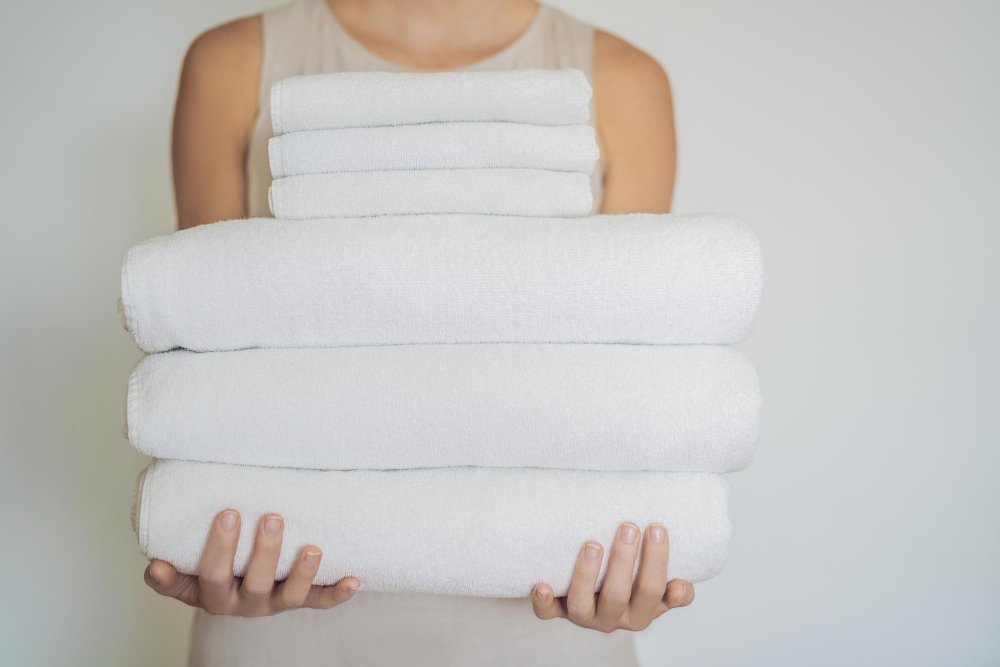
Washing Instructions
- Pre-wash new towels: Wash 2-3 times before first use to remove manufacturing residue and soften fibers. Expect some initial lint shedding – this is normal.
- Water temperature: Use cold or lukewarm water (40°C/104°F maximum). Hot water can cause shrinkage and weaken fibers over time.
- Detergent selection: Use mild, liquid detergent without optical brighteners or enzymes. Avoid products containing:
- Bleach (damages and discolors fibers)
- Fabric softener (creates coating that reduces absorbency)
- Sodium borate, sodium hydroxide, cellulase, protease, or amylase
- Load size: Don’t overfill the washing machine. Linen needs space to move freely for thorough cleaning.
- Wash separately: For the first 3-5 washes, launder linen towels separately as they may shed lint. After that, you can wash them with similar colors.
- Frequency: Linen’s antibacterial properties mean you can use towels 2-3 times before washing (compared to once for cotton).
Drying Instructions
- Air drying (recommended): Hang or lay flat in a well-ventilated area. Linen dries quickly – usually within 2-4 hours. Avoid direct sunlight for colored towels to prevent fading.
- Tumble drying (acceptable): Use low heat only. Remove towels while slightly damp to prevent overdrying, which weakens fibers. High heat causes shrinkage and reduces lifespan.
- Never overdry: Overdrying is the most harmful process for linen. It weakens fibers, causes shrinkage, and leads to pilling.
Additional Care Tips
- Ironing (optional): Iron while slightly damp on medium-high heat with steam. Many people embrace linen’s natural wrinkled texture and skip ironing entirely.
- Stain treatment: Act quickly on stains. Blot (don’t rub) with cold water. For tougher stains, make a paste of mild detergent and water, apply to the spot, and let sit 15-30 minutes before washing.
- Storage: Store completely dry towels in a cool, well-ventilated space. Avoid plastic storage bins that trap moisture.
- Never use: Chlorine bleach, harsh chemicals, or high heat. These damage linen’s natural fibers permanently.
First Wash Expectations
Don’t panic when your new linen towels shed lint during the first few washes. This is completely normal. The towels are releasing excess fibers and softening. By the third or fourth wash, shedding will stop, and the towels will be at their best performance.
Also expect slight shrinkage (2-5%) in the first wash. Buy towels slightly larger than you need if exact dimensions matter to you.
Are Linen Towels Worth the Price?
Let’s talk honestly about cost. Linen towels are more expensive upfront than cotton alternatives:
Current Market Pricing (2025)
- Linen tea towels: $20-40 each
- Linen hand towels: $40-65 each
- Linen bath towels: $75-175 each
- Linen bath sheets: $110-255 each
- Premium heavyweight options: $255-315 each
Compare to cotton:
- Basic cotton towels: $5-15 each
- Mid-range cotton: $15-30 each
- Luxury Egyptian/Turkish cotton: $30-80 each
The Real Value Calculation
Here’s where linen becomes economical. A $100 linen bath towel that lasts 25 years costs you $4 per year. A $20 cotton towel that lasts 5 years costs you $4 per year. They’re the same cost per year of use.
But factor in these additional considerations:
- Replacement hassle: Shopping for and replacing cotton towels every 3-5 years takes time and effort
- Environmental cost: One linen towel vs. five cotton towels over 25 years means less manufacturing, shipping, and landfill waste
- Performance improvement: Cotton towels degrade over time; linen towels improve
- Energy savings: Linen’s quick-drying means less dryer use or faster air-drying
- Storage costs: Linen’s compact size means you can store more in less space
When the Higher Price Makes Sense
Invest in linen towels if you:
- Live in a humid climate where towels struggle to dry
- Value quality items that last decades
- Have limited storage space
- Travel frequently and need lightweight luggage
- Care about environmental impact
- Appreciate items that improve with age
When Cotton Might Be Better
Stick with cotton if you:
- Need to outfit a whole household on a tight budget
- Strongly prefer thick, plush terry cloth feel
- Have young children who are hard on towels
- Don’t mind replacing towels every few years
How to Choose the Right Linen Towel
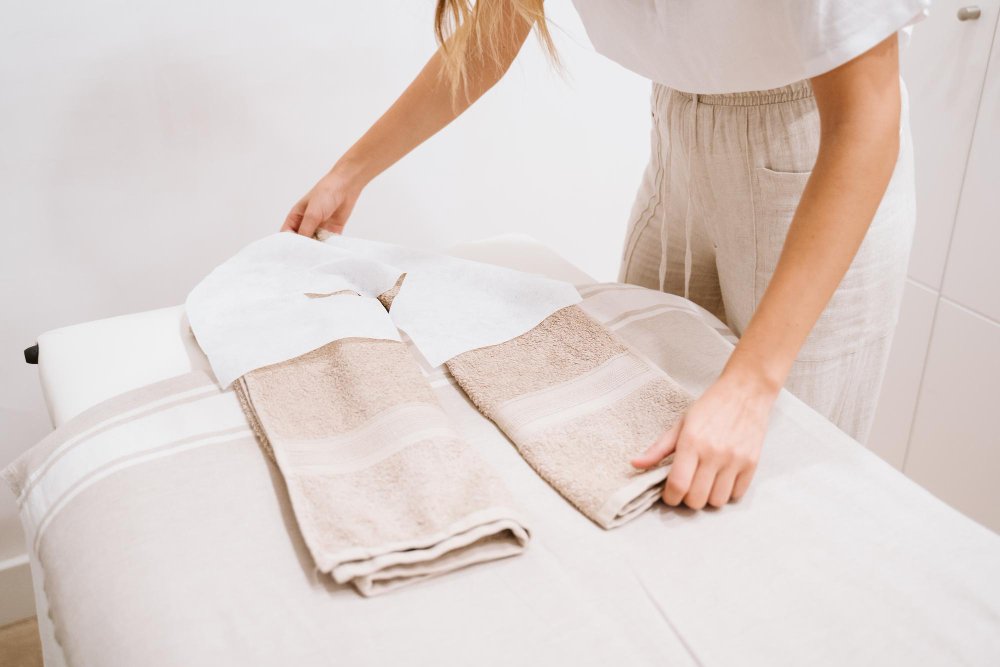
Size Recommendations
Size matters more with linen than cotton because linen towels are less bulky. Here are the recommended dimensions:
- Bath towels: Look for 30″ x 58″ minimum. This gives enough surface area to wrap around yourself and tuck in the edges.
- Bath sheets: 35″ x 70″ or larger. Perfect if you’re taller or prefer more coverage.
- Hand towels: 16″ x 28″ works for most bathroom situations.
- Washcloths: 12″ x 12″ is standard.
Many people find they prefer linen in larger sizes (bath sheets) because the thinner fabric benefits from more surface area.
Quality Indicators
Look for these signs of quality linen:
- European flax: Flax grown in France, Belgium, or the Netherlands is generally highest quality. Look for “European linen” or specific origin labels.
- 100% linen: Pure linen performs better than blends for towels. Avoid “linen-look” cotton blends.
- OEKO-TEX certification: Ensures the fabric is free from harmful chemicals.
- Reinforced edges: Double-stitched hems prevent fraying and extend lifespan.
- Weight consistency: Feel the fabric. It should have uniform thickness with no thin spots.
Weave Types
Plain weave: Smooth, flat surface. Classic linen towel look. Dries fastest but may feel less substantial.
Waffle weave (honeycomb): Textured squares create more surface area. Slightly more absorbent than plain weave with good drying speed. Popular choice for bath towels.
Linen terry (hybrid): Linen warp threads with cotton loops. Offers cotton’s plushness with some of linen’s quick-drying benefits. Good transition option.
Quick Decision Guide
Choose linen towels if you:
- ✓ Live in humid or hot climates
- ✓ Have limited bathroom storage space
- ✓ Travel frequently or go to the gym regularly
- ✓ Want towels that last 20+ years
- ✓ Care about environmental sustainability
- ✓ Have sensitive skin or allergies
- ✓ Appreciate items that improve with age
Choose cotton towels if you:
- ✓ Prefer immediate thick, plush softness
- ✓ Need the lowest possible upfront cost
- ✓ Have ample storage and drying space
- ✓ Like traditional terry cloth feel
- ✓ Don’t mind replacing towels every 3-5 years
Design and Style Options
Linen towels come in a range of designs that blend function with style:
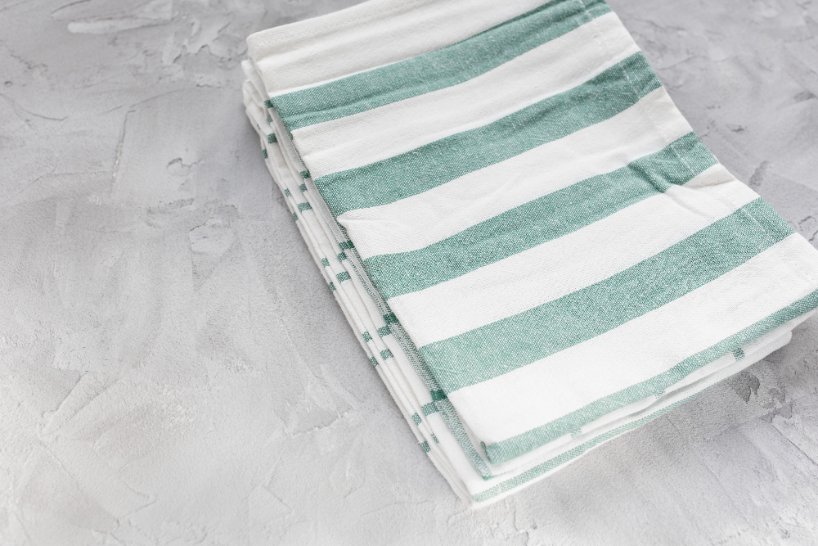
Colors and Patterns
Natural linen comes in beautiful neutral tones – ivory, oatmeal, warm beige, and sandy taupe. These timeless shades work with any bathroom decor and don’t show wear as quickly as white.
Dyed linen towels are increasingly popular in 2025 trends:
- Earthy greens: Sage, olive, and forest green reflect the biophilic design trend
- Muted blues: Slate blue, dusty navy, and soft aqua create spa-like calm
- Warm earth tones: Terracotta, rust, and clay add warmth
- Soft neutrals: Gray, charcoal, and warm beige remain classics
Pattern options include classic stripes (both subtle pinstripes and bold bands), damask borders, and botanical prints in nature-inspired hues.
Embellishments
Monogramming and embroidery are making a comeback in 2025. Adding initials or simple designs personalizes towels and makes them thoughtful gifts. The natural texture of linen provides a beautiful background for embroidered details.
Style Coordination
Linen towels pair beautifully with:
- Natural wood accessories and satin-finished hardware
- Stone or ceramic surfaces
- Plants and natural elements
- Minimalist, Scandinavian-inspired design
- Coastal and Mediterranean aesthetics
The relaxed, slightly rumpled look of linen complements informal, lived-in spaces better than ultra-formal bathrooms.
Honest Drawbacks to Consider
Being upfront about linen’s limitations helps you make an informed choice:
What You Should Know
- Initial texture: New linen towels feel crisp, almost like thick fabric rather than plush terry cloth. Some people describe it as “drying off with a tablecloth.” This changes dramatically after 3-5 washes, but the first impression can surprise people expecting cotton softness.
- Wrinkles: Linen wrinkles naturally. If you want pristine, smooth towels hanging in your bathroom, this might bother you. Most linen lovers embrace the casual, textured look.
- Price barrier: The $75-175 per bath towel price point puts quality linen out of reach for many budgets, especially when outfitting an entire household.
- Limited plushness: Even after years of softening, linen never feels as thick and cushiony as high-GSM cotton terry. If you love that plush spa towel feeling, you might not love linen.
- Color limitations: Because quality linen brands avoid harsh chemical dyes, you get a smaller color palette. Bright colors and patterns are harder to find.
- Initial shedding: New linen towels shed lint for the first few washes. This is normal but can be annoying.
- Learning curve: You need to adjust your care routine (no hot water, no fabric softener). It’s not difficult, but it requires remembering new habits.
Why People Love Them Anyway
- The crisp texture becomes soft and buttery after several washes while maintaining structure
- Wrinkles are part of linen’s charm; many people find them more appealing than perfectly pressed towels
- The price-per-year of use is comparable to constantly replacing cheap towels
- The lighter feel becomes preferred once you experience faster drying and less bulk
- Natural, understated colors are trending and work with changing decor
- Shedding stops completely after a few washes
- Once you adjust your routine, caring for linen is actually easier than cotton
The Adaptation Period
Most people need 2-3 weeks to adjust to linen towels. The first few uses feel different from cotton. Give yourself time to experience how quickly linen dries, how it doesn’t hold odors, and how it softens with use. Many people who initially felt unsure become passionate linen converts after a month.
Frequently Asked Questions
Yes, linen towels absorb water effectively – they can hold up to 20% of their weight before feeling damp. The hollow core structure of linen fibers creates excellent wicking properties. While cotton may feel more absorbent initially due to its thick, plush texture, linen actually absorbs water faster and releases it more quickly, which is why linen dries you off efficiently with less rubbing.
With proper care, linen towels typically last 20-30 years. Some well-maintained linen towels have been passed down through generations. The key factors for longevity are washing in cold or lukewarm water, avoiding harsh chemicals and bleach, and not overdrying. Linen fibers are naturally strong and actually become stronger when wet, which helps them withstand repeated washing better than cotton.
Linen costs more than cotton for several reasons. Growing and harvesting flax is more labor-intensive than cotton production. The process of turning flax stalks into linen fiber involves multiple manual steps including retting, scutching, and spinning. European flax, considered the highest quality, is grown in specific climates with careful agricultural practices. The production process is slower and requires more expertise than cotton processing. However, when you factor in linen’s 20-30 year lifespan versus cotton’s 3-5 years, the cost per year of use becomes similar.
Linen towels may shrink 2-5% during the first wash, especially if washed in hot water. To minimize shrinkage, always wash linen in cold or lukewarm water (maximum 40°C/104°F) and avoid high heat when drying. After the initial wash, properly cared-for linen towels won’t shrink further. If you’re concerned about exact sizing, buy towels slightly larger than you need or pre-wash before use.
Yes, you can tumble dry linen towels on low heat. However, air-drying is recommended because it extends the lifespan of the fibers and prevents shrinkage. If you do use a dryer, remove towels while still slightly damp and use the lowest heat setting. Never use high heat, as it weakens linen fibers and causes shrinkage. The good news is that linen air-dries much faster than cotton (usually 2-4 hours), making air-drying a practical option.
Yes, this is one of linen’s best features. Brand new linen towels feel crisp and slightly stiff. With each wash and use, the fibers relax and soften naturally without losing strength. After 5-10 washes, linen develops a soft, buttery texture that continues to improve over the years. Many people report their 5 or 10-year-old linen towels are softer and more comfortable than new ones. You never need fabric softener – the softening happens naturally.
Yes, linen is naturally hypoallergenic and has a neutral pH balance that’s gentle on sensitive skin. The fabric doesn’t retain moisture, which means less opportunity for bacteria or mildew to grow and irritate skin. Linen’s slightly textured surface provides gentle exfoliation without being abrasive. Many dermatologists recommend linen for people with eczema, allergies, or reactive skin. Additionally, quality linen towels are produced without harsh chemical treatments that can trigger sensitivities.
For bath towels, look for minimum dimensions of 30″ x 58″. This provides enough surface area to wrap around yourself comfortably. Because linen is thinner than cotton terry, the extra size compensates for less bulk. Bath sheets (35″ x 70″) are popular for linen because they offer more coverage. If you’re tall or prefer maximum coverage, go with bath sheet sizing. For hand towels, 16″ x 28″ works well for most bathrooms.
Never use chlorine bleach on linen towels. Bleach permanently damages linen fibers, causes discoloration (even on white linen), and creates weak spots that lead to tearing. If you need to brighten white linen, use oxygen-based bleach (like OxiClean) sparingly on white towels only. For regular cleaning, mild detergent and sunlight are your best options. The good news is that linen’s natural antibacterial properties and quick-drying nature mean it stays fresher than cotton, reducing the need for heavy-duty cleaning.
Linen towels are excellent for travel. They weigh about half what cotton towels weigh, freeing up luggage space and weight allowance. They dry quickly (often overnight in a hotel room), so you can reuse them rather than packing multiple towels. Linen doesn’t retain odors even when damp, which is helpful when packing partially dry towels. The compact size means they take up minimal space in your bag. Many frequent travelers consider linen towels a game-changer for their trips.
100% linen towels are made entirely from flax fibers and offer the full benefits of linen: maximum durability, fastest drying, strongest fibers, and best longevity. Linen blend towels (often linen-cotton blends) combine some linen characteristics with cotton’s softness. Blends are usually softer initially but don’t dry as quickly, don’t last as long, and don’t have the same strength as pure linen. For kitchen towels and decorative uses, blends work fine. For bath towels where performance matters, 100% linen is worth the investment.
New linen towels feel crisp and textured because the fibers haven’t relaxed yet. This is completely normal and temporary. The stiffness comes from the natural structure of flax fibers and sometimes from light starching during manufacturing. After 3-5 washes, linen begins softening noticeably. By 10 washes, the texture transforms into a soft, comfortable feel. This initial crispness is actually a sign of quality linen – the tighter the weave and stronger the fibers, the more crisp they feel when new.
Conclusion
Linen towel fabric represents a smarter long-term investment for most households than traditional cotton terry cloth. While the higher upfront cost can seem daunting, the 20-30 year lifespan, superior performance characteristics, and environmental benefits make linen towels more economical and practical over time.
The decision ultimately comes down to your priorities. If you value durability, quick-drying properties, compact storage, and true sustainability, linen towels deliver unmatched performance. They’re particularly well-suited for humid climates, small bathrooms, active lifestyles, and people with sensitive skin. The initial crisp texture softens beautifully through use, creating towels that actually improve with age rather than deteriorating like cotton alternatives.
However, linen isn’t for everyone. If you strongly prefer the immediate plush softness of terry cloth, have budget constraints that make the initial investment difficult, or simply love traditional cotton towels, there’s no shame in sticking with what works for you. The best towel is the one you’ll actually use and care for properly.
Key Takeaways
- Lifespan matters: Linen towels last 20-30 years versus 3-5 years for cotton, making the cost per year comparable despite higher initial prices
- Performance advantages: Linen dries 2-3x faster than cotton, holds 20% of its weight in water, is 30% stronger than cotton, and resists odors naturally
- Care is key: Wash in cold or lukewarm water with mild detergent, never use fabric softener or bleach, and avoid overdrying to maximize lifespan
- Size up: Buy larger sizes (30″ x 58″ minimum for bath towels) because linen’s thinner weave needs more surface area than bulky cotton
- Texture evolution: New linen feels crisp but transforms into soft, buttery texture after 5-10 washes and continues improving for years
- GSM context: Linen bath towels at 300-400 GSM perform comparably to 600+ GSM cotton due to superior fiber structure
- Environmental choice: Linen requires less water, fewer pesticides, and no irrigation to grow; completely biodegradable with zero waste
- Best uses: Humid climates, travel, gym use, small spaces, and sensitive skin benefit most from linen’s properties
- Adaptation period: Give yourself 2-3 weeks to adjust to linen’s different feel; most people become enthusiastic converts
- Investment mentality: Treat linen towels as long-term household investments rather than disposable items – buy quality, care properly, and enjoy for decades
Final Recommendations
If you’re new to linen, start with one or two bath towels rather than replacing your entire linen closet at once. This allows you to experience linen’s performance without major financial commitment. Choose a neutral color that will age well and work with changing bathroom decor.
Look for European linen with OEKO-TEX certification from reputable manufacturers. Pay attention to GSM (300-350 for versatile everyday use) and size (larger is better for bath towels). Read care instructions carefully and commit to following them – proper care is what makes linen last decades.
For those living in humid climates, dealing with limited storage space, or frustrated with musty-smelling cotton towels, linen solves practical problems while delivering luxury that improves over time. The higher price tag makes sense when you consider you’re buying a towel once instead of five or six times over the same period.
Ultimately, linen towels combine functionality with sustainability, offering a textile that gets better with age while treading lightly on the planet. Whether you’re upgrading your own bathroom or searching for a thoughtful gift, quality linen towels deliver lasting value that cotton simply can’t match.

